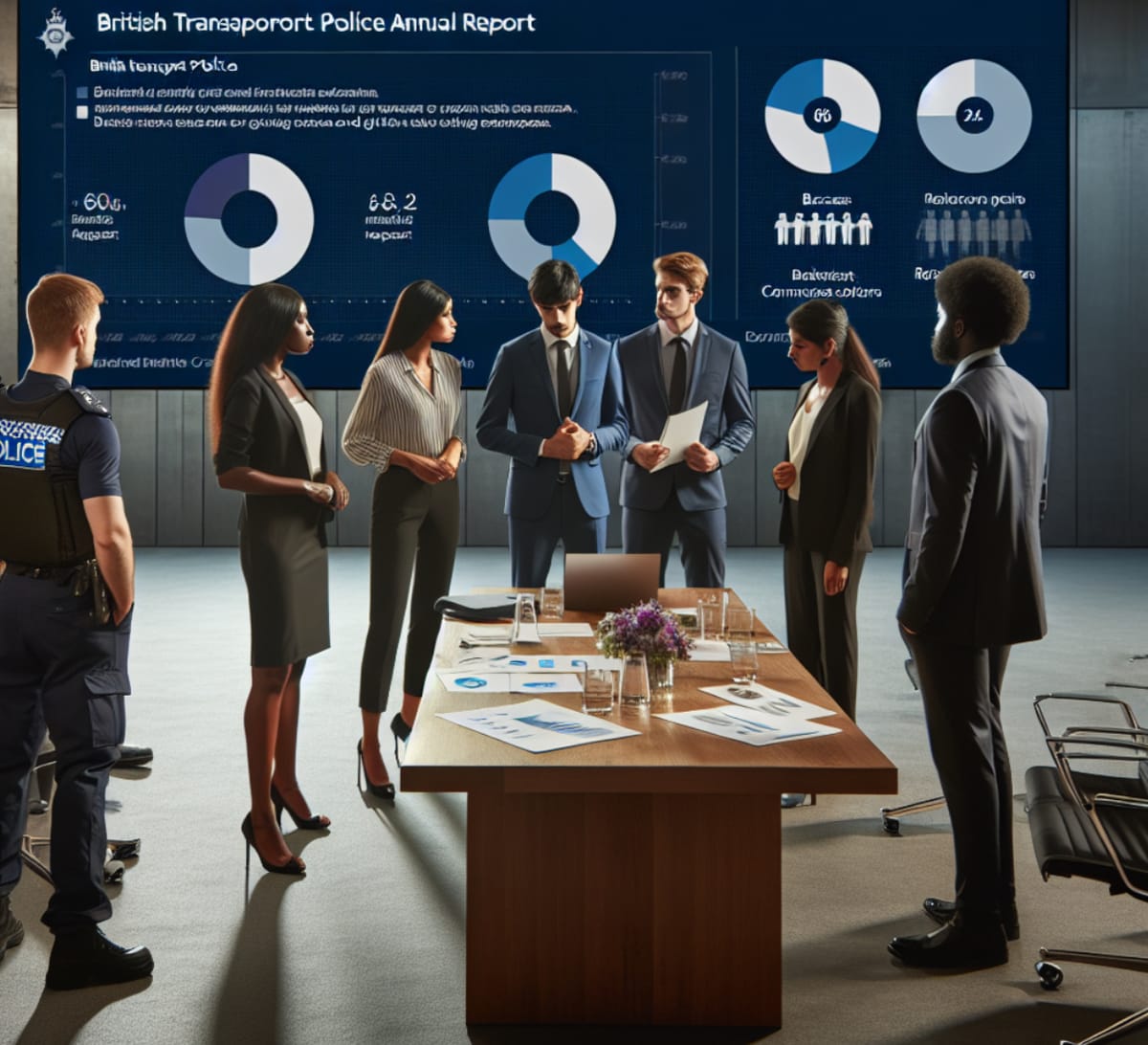Responding to the British Transport Police Annual Report on the Increase in Violence Against Women and Girls

The latest British Transport Police (BTP) Annual Report shines a stark light on an unsettling trend—an increase in violence against women and girls on public transport. This escalation in abuse is not just statistics on paper; it reflects real situations faced by women daily. At Stay Safe Global, we are committed to ensuring women's safety everywhere, especially in spaces where they are most vulnerable. It is fundamentally important that everyone, regardless of gender, feels safe and secure while using public transport. Public transportation systems are meant to serve as vital lifelines, connecting individuals to their families, jobs, and communities. No one should have to tolerate the threat of violence, harassment, or intimidation during their commute. We must all advocate for a transformative approach that prioritises the safety of every passenger. This includes fostering a culture of respect among commuters, implementing robust support systems, and encouraging bystander intervention. By taking collective action, we can create an environment where everyone can travel without fear, knowing that their safety is a shared responsibility. This blog examines the report's findings, discusses their broader implications, and explores potential solutions to this pressing issue.
Understanding the Statistics
The British Transport Police Annual Report for 2023-2024 highlights a concerning rise in reported incidents of violence against women and girls on public transportation. According to the report, there has been a 23% increase in such cases compared to the previous year. These incidents range from verbal harassment and physical assaults to more severe forms of violence. These incidents are not isolated but part of a broader pattern of gender-based violence.
One statistic that stands out is the notable increase in reported sexual harassment cases, which have gone up by 18%. This rise is alarming and suggests that public transport is becoming increasingly unsafe for women and girls. The report also notes a troubling trend of underreporting, with many victims reluctant to come forward due to fear of not being taken seriously or facing retaliation.
Diving deeper into the Report, it is vital to acknowledge the demographic disparities that exist within these statistics. Notably, women aged 16 to 25 represent a significant proportion of the reported incidents, accounting for nearly 40% of all cases. This age group not only experiences an alarming rate of violence but is also disproportionately affected by harassment during peak travel times, particularly in the evenings and on weekends.
The BTP has identified certain hotspots where these incidents are more frequent, particularly during late-night travel. By understanding these patterns, we can begin to address the root causes and implement targeted interventions. A geographical breakdown of the data reveals that urban areas tend to have higher instances of violence against women, with London alone reporting a staggering 35% of total incidents. This concentration underscores the urgent need for targeted safety measures in densely populated transport hubs.
Dissapointingly, the report indicates that while the overall number of reported incidents has risen, there has been a notable decline in successful prosecutions. Only about 15% of reported cases led to a conviction, highlighting a critical gap in the justice process that survivors face. This statistic not only stresses the need for improved reporting mechanisms but also calls for systemic changes to the way authorities respond to and manage such cases.
By dissecting these statistics, it becomes increasingly clear that a multifaceted approach is required. We must advocate for enhanced training for transport staff, rigorous data collection that informs policy, and community engagement initiatives aimed at empowering victims and fostering a culture of vigilance among all passengers. Only through concerted efforts can we hope to stem the tide of violence and ensure a safe travel experience for women and girls.
Impact on Communities
The ripple effects of increased violence against women and girls on public transport extend beyond the individuals directly affected. Communities become fragmented as fear and mistrust grow. Women may start to avoid public transport altogether, limiting their mobility and access to essential services and opportunities. This avoidance can lead to increased reliance on private transport, which is not always affordable or accessible, further exacerbating economic disparities.
The economic impact is significant as well. Businesses suffer when employees feel unsafe commuting to work, leading to increased absenteeism and decreased productivity. The healthcare system also bears the burden of treating physical and psychological trauma resulting from these incidents. Real-life examples highlight these impacts vividly. For instance, a woman who was assaulted on her way to work might experience long-term anxiety, affecting her ability to perform her job and participate in community activities.
Response and Solutions
Addressing this issue requires a multifaceted approach. Current initiatives and best practices aimed at improving women's safety on public transport offer a roadmap for action. In the UK, several measures have been implemented to tackle this issue head-on.
Enhanced Surveillance and Reporting Mechanisms
One promising initiative is the installation of more surveillance cameras on public transport and in stations. These cameras act as a deterrent and provide crucial evidence if an incident occurs. Additionally, the BTP has introduced easier reporting mechanisms, such as mobile apps and text services, to encourage victims to report incidents promptly.
Public Awareness Campaigns
Public awareness campaigns play a vital role in changing societal attitudes towards violence against women. These campaigns educate the public on the importance of bystander intervention and encourage witnesses to report any suspicious activity. They also aim to destigmatize the reporting process for victims, making it easier for them to seek help.
Training for Transport Staff
Training programs for transport staff are essential. Staff members are often the first point of contact for victims and need to be equipped with the skills to handle such situations sensitively and effectively. This training includes recognizing the signs of harassment, providing immediate support to victims, and understanding the legal procedures involved.
Collaboration with Tech Companies
Technology can also contribute to enhancing safety. Collaborations with tech companies have led to the development of safety apps that allow users to share their location with trusted contacts, access emergency services quickly, and receive real-time alerts about unsafe areas.
International Best Practices
Globally, there are several best practices that the UK can learn from. For instance, cities like New York and Paris have implemented female-only transport options during late hours to provide a safer environment for women. Additionally, countries like Japan have stringent penalties for offenders, which serve as a strong deterrent against such crimes.
A Synergy with the Worker Protection Act
In light of the concerning statistics and their broader implications, there is a crucial synergy with the incoming UK Worker Protection Act that cannot be overlooked. This legislation mandates employers to ensure the safety and wellbeing of their employees, extending beyond the traditional confines of the workplace. As employees commute to and from work, employers share the responsibility for their safety while using public transport. By acknowledging this duty, companies can implement measures such as providing safety training, offering resources for reporting incidents, and facilitating safe travel options. Moreover, integrating a commitment to transport safety into corporate policies reflects a compassionate and action-oriented approach to employee wellbeing. It also sends a clear message that violence against women and girls is not tolerated, fostering a culture of respect and supporting broader community efforts to combat this pervasive issue. Employers must actively collaborate with local transport authorities and community organisations to create safer environments, ensuring that the journey to work is as secure as the workplace itself.
Join the Conversation
Your voice matters. Sharing your experiences and insights can significantly contribute to improving safety measures. We encourage business leaders, HR professionals, public safety advocates, and everyday commuters to join the conversation. Share your experiences, propose solutions, and support initiatives aimed at making public transport safer for everyone.
Participating in community safety forums, supporting local women's safety organizations, and advocating for better policies are just a few ways you can make a difference. By working together, we can create a safer and more inclusive environment for all.
Conclusion
The increase in violence against women and girls on public transport, as highlighted in the British Transport Police Annual Report, is a grave concern that requires immediate and sustained action. This issue affects not only the victims but also our communities, economy, and societal well-being.
At Stay Safe Global, we believe in the power of collective action and the importance of creating safe spaces for women. Through our initiatives, we aim to empower individuals, educate communities, and advocate for stronger policies to protect women and girls.
We invite you to join us in this mission. Contact us to learn more about how you can get involved, whether through supporting our initiatives, participating in our training programs, or simply spreading the word. Together, we can make a difference and ensure that public transport is safe for everyone.
For more information and to take action, visit our website. Your support is crucial in driving change and ensuring a safer future for all women and girls.





